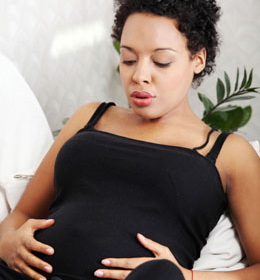Are you suffering from upper thigh pain while you are pregnant? Well, you are not alone, for this is a common side effect of pregnancy. Gain some knowledge about the causes and symptoms of this condition, and opt for the treatment options suggested in this Buzzle article.

Pregnancy comes with its own share of problems and physical discomfort. Although, a woman is elated by the prospect of motherhood, pregnancy anxiety and discomfort may dampen her spirit to some extent. Upper thigh pain is one such problem, which plagues millions of pregnant women. The extent and type of pain may vary for every woman depending upon the phase of pregnancy that she is in.
Causes
As mentioned above, pregnancy is a period, wherein, a woman's body undergoes a sea change. Hormone levels go awry with pregnancy hormones dominating the body. One such hormone that is rampant during pregnancy is relaxin. As the name suggests, relaxin essentially relaxes the muscles and tendons of the pelvic region to facilitate childbirth. On the flip side, it loosens the ligaments of the pubic joint (symphysis pubis), which holds it in place. As a result of this, the pelvic joint becomes unstable, leading to pain. This condition is called
Symphysis Pubis Dysfunction (SPD). It is mainly the cause of upper thigh pain during early pregnancy.
During the later stages of pregnancy, the growing uterus may cause a series of problems, thigh pain being one of them. At such time, upper thigh pain is mainly due to sciatica. Sciatica pain occurs when the sciatic nerve, which runs from lower back to thighs to feet, gets compressed due to some reason. In late pregnancy, the reason is the growing uterus, which exerts pressure on the sciatic nerve, inducing excruciating pain.
Symptoms
Pain in the thighs may come and go with movements, or it may be present all the time. If the cause of pain is SPD, then the woman experiences throbbing pain in upper inner thigh, buttocks, and in the entire pelvic region. The pain aggravates while sitting, walking, or even moving legs. The woman may also feel a sensation of grinding of bones or clicking, popping noises from the pelvic joint. Pain due to SPD can be experienced on both sides or only one side. If the cause of pain is sciatica, then you should expect pain only on one side. The pain is sharp with a burning, tingling sensation. Instead of persistent pain, you may only experience painful bouts with tingling.
Controlling the Pain
The pain and all the associated physical discomfort should go away after delivery, without any treatment. However, if you find it difficult to bear the pain during pregnancy, you can certainly take some measures to control it. Crutches and pelvic support belt may minimize the pain, while walking. Physiotherapy exercises prove to be the most effective way of managing pain. Pelvic floor exercises, which strengthen the muscles and ligaments of the pelvic region, are also helpful. However, before starting any exercises, it is important to get a green signal from your OB-GYN. Sciatica pain can be controlled by sleeping on the other side, so that the compressed nerve is not subjected to additional pressure. Some over-the-counter medications may also prove to be of great help in managing thigh pain. However, it is not recommended that you take medications without consulting your OB-GYN. Thus, whenever the pain becomes unbearable, see your OB-GYN without delay.
If you perform light exercises right from the beginning of your pregnancy, then you might be able to cope with pregnancy discomfort in a better way. Thigh pain is generally not a cause of concern, and should settle on its own in the final stages of pregnancy, when the baby positions itself for birth.


 Pregnancy comes with its own share of problems and physical discomfort. Although, a woman is elated by the prospect of motherhood, pregnancy anxiety and discomfort may dampen her spirit to some extent. Upper thigh pain is one such problem, which plagues millions of pregnant women. The extent and type of pain may vary for every woman depending upon the phase of pregnancy that she is in.
Pregnancy comes with its own share of problems and physical discomfort. Although, a woman is elated by the prospect of motherhood, pregnancy anxiety and discomfort may dampen her spirit to some extent. Upper thigh pain is one such problem, which plagues millions of pregnant women. The extent and type of pain may vary for every woman depending upon the phase of pregnancy that she is in.